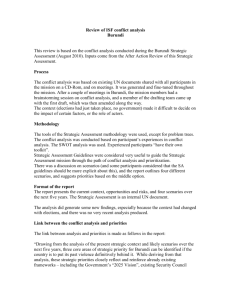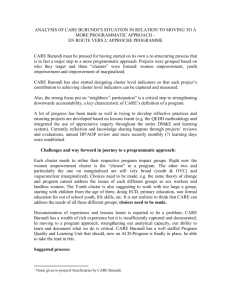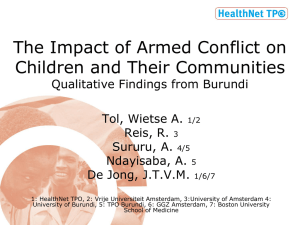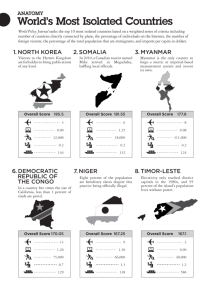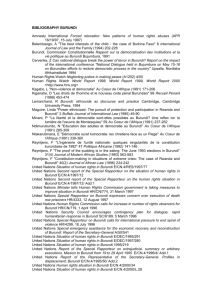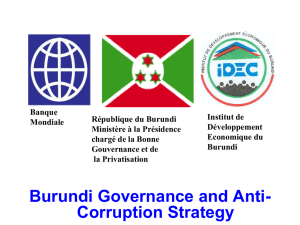here
advertisement
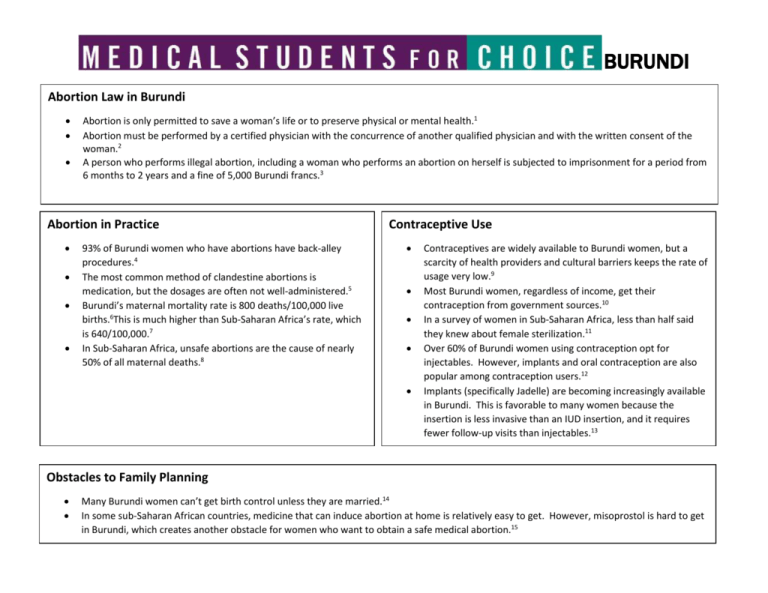
BURUNDI Abortion Law in Burundi Abortion is only permitted to save a woman’s life or to preserve physical or mental health.1 Abortion must be performed by a certified physician with the concurrence of another qualified physician and with the written consent of the woman.2 A person who performs illegal abortion, including a woman who performs an abortion on herself is subjected to imprisonment for a period from 6 months to 2 years and a fine of 5,000 Burundi francs.3 Abortion in Practice 93% of Burundi women who have abortions have back-alley procedures.4 The most common method of clandestine abortions is medication, but the dosages are often not well-administered.5 Burundi’s maternal mortality rate is 800 deaths/100,000 live births.6This is much higher than Sub-Saharan Africa’s rate, which is 640/100,000.7 In Sub-Saharan Africa, unsafe abortions are the cause of nearly 50% of all maternal deaths.8 Contraceptive Use Contraceptives are widely available to Burundi women, but a scarcity of health providers and cultural barriers keeps the rate of usage very low.9 Most Burundi women, regardless of income, get their contraception from government sources.10 In a survey of women in Sub-Saharan Africa, less than half said they knew about female sterilization.11 Over 60% of Burundi women using contraception opt for injectables. However, implants and oral contraception are also popular among contraception users.12 Implants (specifically Jadelle) are becoming increasingly available in Burundi. This is favorable to many women because the insertion is less invasive than an IUD insertion, and it requires fewer follow-up visits than injectables.13 Obstacles to Family Planning Many Burundi women can’t get birth control unless they are married.14 In some sub-Saharan African countries, medicine that can induce abortion at home is relatively easy to get. However, misoprostol is hard to get in Burundi, which creates another obstacle for women who want to obtain a safe medical abortion.15 BURUNDI Works Cited: 1 Burundi. Women on Waves. http://www.womenonwaves.org/en/page/3179/burundi Accessed August 24, 2015. 2 World Population Policies Database. United Nations: Department of Economic and Social Affairs. http://esa.un.org/PopPolicy/about_database.aspx Accessed August 24, 2015. 3 Ibid. 4 Ciza JM. Abortion taboo puts Burundi’s rape and incest survivors in danger. The Observers. June 11, 2015. http://observers.france24.com/en/20150605burundi-rape-incest-survivors-abortion-taboo Accessed August 24, 2015. 5 Ibid. 6 Tayler-Smith K, Zachariah R, Manzi M, et al. Achieving the Millennium Development Goal of reducing maternal mortality in rural Africa: an experience from Burundi. Tropical Medicine and International Health. February 2013; 18(2): 166-174. doi:10.1111/tmi.12022 7 Abortion: Facts and Figures. Population Reference Bureau. 2011. http://www.prb.org/pdf11/abortion-facts-and-figures-2011.pdf Accessed August 24, 2015. 8 Ibid. 9 Ndayizigiye M. Assessment of Barriers of Contraceptive Use in Rural Burundi: A Mixed Methods Study. 2014. Master’s thesis, Harvard Medical School. http://dash.harvard.edu/bitstream/handle/1/13041361/NDAYIZIGIYE-MASTEROFMEDICALSCIENCESTHESIS-2014.pdf?sequence=1 Accessed August 24, 2015. 10 Burundi. Track 20 website. http://www.track20.org/pages/countries/all-countries/burundi Accessed August 24, 2015. 11 Ripley F and Salem RM. Essential Knowledge About Female Sterilization: Permanent Methods Toolkit. K4Health. 2012. http://www.k4health.org/toolkits/permanent-methods/female-sterilization Accessed August 24, 2015. 12 Mutombo N. Are Implants the Future of Family Planning in Burundi? African Population and Health Research Center. October 16, 2013. http://aphrc.org/are-implants-the-future-of-family-planning-in-burundi/ Accessed August 24, 2015. 14 Ciza JM. 15 Burundi. Women on Waves.
